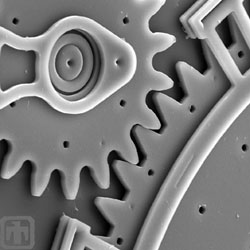Small Structures Act Big

As technology continues to shrink devices, it challenges scientists’ understanding of even the most basic materials. A study appearing in the 24 September print issue of PRL tries to set the microscopic scale at which a simple metal no longer acts like a macroscopic piece of material. The researchers created nanometer-sized structures in copper in order to study the scale at which copper’s fundamental properties, such as its plasticity, begin to change. Their surprising results show that copper’s characteristics hold up even at sizes where most believed they would break down. Researchers hope to use these results everywhere metals are used: from computer chip manufacturing to automobiles, and even in nanotechnology.
“As folks are working on smaller and smaller kinds of structures,” explains Darcy Hughes of Sandia National Laboratories in Livermore, CA, “the question comes up: do the rules we know for average-sized structures still hold as we get smaller?” To find out, Hughes and Niels Hansen of the Ris Laboratory in Roskilde, Denmark, dragged a steel bar across the surface of a copper block to stress the copper crystal lattice. They wanted to examine the affected upper layers of copper, but since slicing the block with a knife would have disturbed the microscopic deformations, they used an ion beam to gently carve out a crater several micrometers deep.
Hughes and Hansen imaged the block’s upper layers with a transmission electronmicroscope and saw crack-like patterns of crystal deformations throughout the copper lattice. The crystalline islands between the walls of deformation looked something like living cells, except that their size increased with distance below the copper surface. In a normal chunk of metal, similar microscopic deformation patterns are essential to properties such as strength and malleability. After analyzing the images, the team found that regions at the surface–where the cells were smallest–looked like miniature versions of regions below the surface which had larger cells. They had expected the patterns of cells and walls to change at some small scale, signaling a change in the fundamental properties of the copper block. But Hughes says the patterns remained unchanged, even at the smallest scales created, between about 3 and 10 nm.
“The overall quality of this work is excellent,” says Wilhelm Wolfer of Lawrence Livermore National Laboratories in California. Wolfer believes that Hughes and Hansen’s work will lead to laws that can be used for manufacturing on the microscale in everything from computers to automobiles. He also hopes to use the team’s results in his own supercomputer calculations of defect structures in metals. “Their work will really guide us in this effort,” he says.
–Geoff Brumfiel


